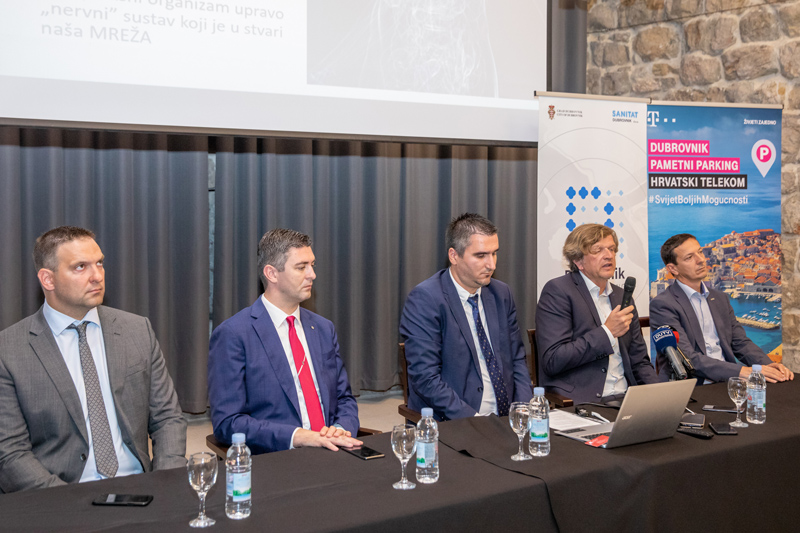10.7.2019
- It is the largest project in the segment of smart parking and smart cities in Croatia and the region and one of the largest smart parking projects in the world realized with this number of sensors on the NB-IoT network
- Hrvatski Telekom is the holder of this project worth HRK 3.2 million
- As many as 1900 sensors will make it easier to find an available parking space and reduce traffic jams
 Mateo Perak, Profico; Mato Franković, Dubrovnik mayor; Tomislav Tabak, CEO of Sanitat; Saša Kramar, Hrvatski Telekom MB member and Krešimir Meštrić, Mobilisis
Mateo Perak, Profico; Mato Franković, Dubrovnik mayor; Tomislav Tabak, CEO of Sanitat; Saša Kramar, Hrvatski Telekom MB member and Krešimir Meštrić, Mobilisis
This 3.2 million kuna worth project, headed by Hrvatski Telekom, implemented smart parking in the entire Dubrovnik, setting up 1900 sensors for finding available parking spaces and reducing traffic jams.
The Dubrovnik smart parking project results from the decisions of the City of Dubrovnik and the utility company Sanitat Dubrovnik d.o.o. to implement smart parking in the entire urban area. For this purpose, they provided the necessary funds and announced a tender, which resulted in the realization of a smart parking project, which in technological and network terms is based on state-of-the-art technology. This project is part of a range of activities under the umbrella “Dubrovnik Smart City” project, stemming from the “Strategy of Smart City Dubrovnik”, a strategic document with which Dubrovnik decided to develop in the direction of the smart city.
Partners of Hrvatski Telekom in the deployment were Mobilisis, manufacturer of sensors for vehicle detection and displays for traffic participants and IoT sensor platform, Profico, which was responsible for creating a mobile application for citizens, and Furia, which enabled installation and activation of field sensors.
“Even in technologically advanced countries, there is no such a comprehensive project of smart parking realized on the most modern NB-IoT network whose experience we could follow. So, we believe many will follow ours. Hrvatski Telekom is strategically oriented toward the construction of smart cities and their digital transformation, which includes the use of modern technologies to increase the quality of life of citizens, optimize local resources, and develop entrepreneurship,” pointed out Saša Kramar, Member of the HT Management Board and Chief Operating Officer Business.
The sensors installed at each parking place in the city can accurately detect when there is a car there, whether a particular place is free or occupied, and that information is then sent to a central location and a free application available to citizens. Taking into account the number of sensors and the fact that they are placed all over Dubrovnik, it is one of the largest integrated solutions for smart parking on the Narrowband IoT (NB-IoT) network in the world and the largest project in the segment of smart cities in Croatia and the region.
For drivers to see at any given moment which parking space is free, and plan where to park, a mobile application is available to everyone, both for Dubrovnik citizens and tourists. This saves time to drivers in finding an available parking space and reduces the crowd caused by the drivers who circle the streets in search of an available spot.
In some places in the city, a system of twenty public information displays has been set up so that those citizens who do not use the application would be able to see available parking places a few streets earlier to see in time what location is available.
For sensors to be more efficient and cost-effective, and the smart parking solution sustainable in the long run, it was developed on the NB-IoT network of Hrvatski Telekom. This network is based on the global industry standard for mobile networks and enables the connection of an extremely high number of connected IoT devices. It features excellent coverage, low cost, high signal quality, and a high level of security and reliability in line with global telecommunications standards in mobile networks.
The smart parking project is primarily in the service of citizens, as it allows drivers to find an available parking space faster and easier, offers them the closest alternative available parking spaces and directs them to it, as well as fairer charges and control. Benefits for citizens are multiple - from fewer traffic jams and time and fuel savings, to lower stress levels and fewer emissions of harmful gases.